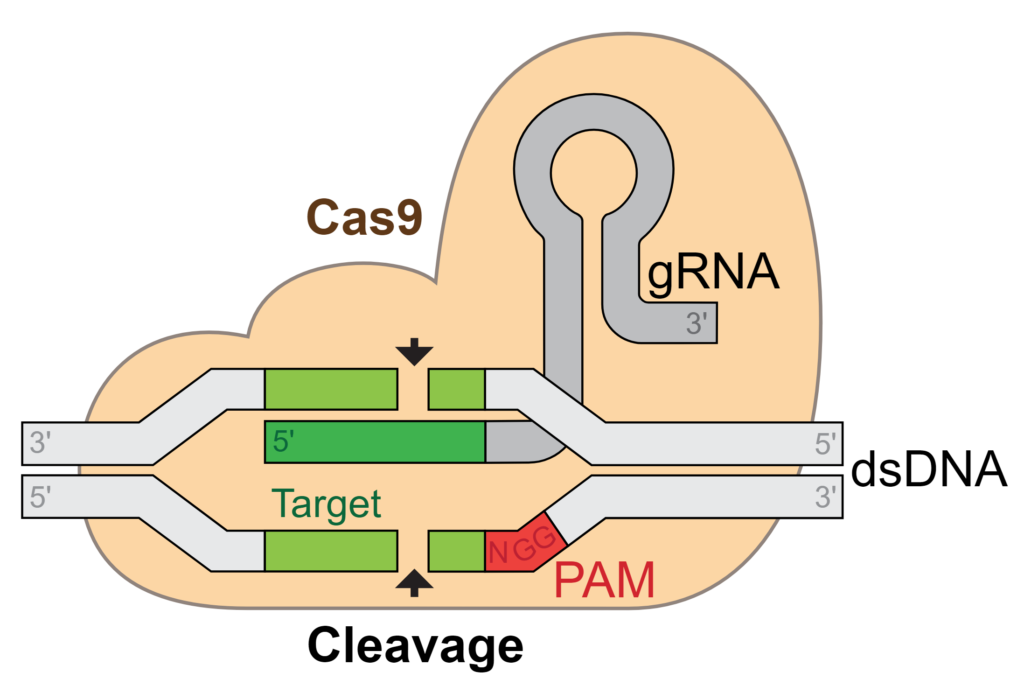“CRISPR” (pronounced “crisper”) stands for Clustered Regularly Interspaced Short Palindromic Repeats, which are the hallmark of a bacterial defense system that forms the basis for CRISPR-Cas9 genome editing technology.

In the field of genome engineering, the term “CRISPR” or “CRISPR-Cas9” is often used loosely to refer to the various CRISPR-Cas9 and -CPF1, (and other) systems that can be programmed to target specific stretches of genetic code and to edit DNA at precise locations, as well as for other purposes, such as for new diagnostic tools.
Discovery of CRISPR
CRISPRs were first discovered in archaea (and later in bacteria) by Francisco Mojica . He proposed that CRISPRs serve as part of the bacterial immune system, defending against invading viruses. They consist of repeating sequences of genetic code, interrupted by “spacer” sequences – remnants of genetic code from past invaders. The system serves as a genetic memory that helps the cell detect and destroy invaders (called “bacteriophage”) when they return.
Functioning of CRISPR-Cas9 system
CRISPR “spacer” sequences are transcribed into short RNA sequences (“CRISPR RNAs” or “crRNAs”) capable of guiding the system to matching sequences of DNA. When the target DNA is found, Cas9 – one of the enzymes produced by the CRISPR system – binds to the DNA and cuts it, shutting the targeted gene off. Using modified versions of Cas9, researchers can activate gene expression instead of cutting the DNA. These techniques allow researchers to study the gene’s function.
Comparison with other genome editing tools
CRISPR-Cas9 is proving to be an efficient and customizable alternative to other existing genome editing tools because
1 . Since the CRISPR-Cas9 system itself is capable of cutting DNA strands, CRISPRs do not need to be paired with separate cleaving enzymes as other tools do.
2 . They can also easily be matched with tailor-made “guide” RNA (gRNA) sequences designed to lead them to their DNA targets.
3 . CRISPR-Cas9 can also be used to target multiple genes simultaneously, which is another advantage that sets it apart from other gene-editing tools.
Significance of CRISPR-Cas9 genome editing technology
With these systems, researchers can permanently modify genes in living cells and organisms and, in the future, may make it possible to correct mutations at precise locations in the human genome in order to treat genetic causes of disease. Other systems are now available, such as CRISPR-Cas13’s, that target RNA provide alternate avenues for use.
Thus CRISPR genome editing allows scientists to quickly create cell and animal models, which researchers can use to accelerate research into diseases such as cancer and mental illness. In addition, CRISPR is now being developed as a rapid diagnostic tool.
PRACTICE QUESTIONS
QUES . Consider the following pairs : UPSC 2018
Terms sometimes seen in news – Context /Topic
1 . Belle II experiment – Artificial Intelligence
2 . Blockchain technology – Digital/Cryptocurrency
3 . CRISPR — Cas9 – Particle Physics
Which of the pairs given above is/are correctly matched ?
(a) 1 and 3 only
(b) 2 only
(c) 2 and 3 only
(d) 1, 2 and 3
Ans (b)
